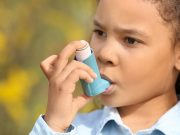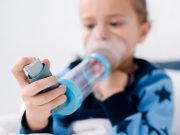Tag: Asthma
Inhaler-Related Emissions Increased 24 Percent From 2014 to 2024
87 percent of total emissions were accounted for by albuterol, budesonide-formoterol, fluticasone propionate inhalers
Budesonide-Formoterol More Effective Than Salbutamol for Preventing Asthma Attacks in Children
Similar safety profile seen in children with mild asthma aged 5 to 15 years
AAP: Routine Asthma Symptom Screening Improves Pediatric Diagnoses
High prevalence of poor housing quality seen in children diagnosed with asthma and even higher prevalence seen in those with underdiagnosed asthma
Children With Chronic Conditions More Likely to Have Food Insecurity
After controlling for family and child characteristics, the difference was attenuated but persisted
Early Exposure to Dogs May Reduce Risk for Childhood Asthma
No link seen between early exposure to cat allergens and asthma risk
Inhaled Cannabis Linked to Risk for Asthma, COPD
Daily use of inhaled cannabis linked to increased risks, with risk for asthma significantly increased even with no lifetime tobacco cigarette use
Natural Language Processing Algorithms Can ID High-Risk Childhood Asthma Subgroup
Pneumonia, influenza A/B, and asthma exacerbation risks highest in those positive for both Predetermined Asthma Criteria and Asthma Predictive Index
Variables Associated With Heart Failure Compared for Men and Women
Asthma, depression, anxiety, hypothyroidism linked to both heart failure with preserved and reduced ejection fraction in women
GERD Linked to Increased Incidence of Pulmonary Disease
No significant associations seen between treated gastroesophageal reflux disease and incidence of asthma or lung cancer
Six in 10 Children With Asthma Meet Guideline Diagnostic Criteria
Children with guideline-confirmed diagnosis have greater improvement in lung function and a higher risk for acute asthma events














